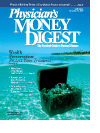Publication
Article
Physician's Money Digest
Prevent Vacation Home Flood Calamities
Author(s):
Vacation homes can be wonderful retreats.However, since they are often located inwaterfront locations or isolated rural areas,they can be vulnerable to storms, floods, andother unexpected natural disasters. While enlisting theaid of property managers and friendly neighbors canoften help with the physical tasks of "battening downthe hatches," vacation homeowners need to employ abetter defense against natural disasters.
Smart homeowners should have another line ofdefense: flood insurance. "Many people assume thatbecause they have a comprehensive homeowner's insurancepolicy, it covers every hazard," says MarkStevens of the Federal Emergency Management Agency(FEMA). "But there are two exceptions: earthquakesand floods; and floods are far and away the most commontype of natural disaster in the United States."
Necessary Protection
Most US vacation homeowners can purchase floodprotection through the National Flood InsuranceProgram (NFIP; 800-427-4661; www.fema.gov/nfip).This federally backed program is available to homeownersin nearly 20,000 participating communities.The NFIP represents approximately 4.4 million policiesand has more than $648 billion worth of coverage.This insurance can be purchased by homeownersthrough most insurance agents.
"FEMA sets the rates, so the premium will be thesame for a particular property, regardless of which agentor company writes the policy," says Anthony S. Lowe,NFIP administrator. Thus, it's usually a good idea tohave the same agent who writes your homeowner's policyalso write your flood insurance policy. If your agentdoesn't write flood insurance policies, contact the NFIPfor participating agents in your area.
Currently, the average annual premium is $405 andthe average coverage amount is $147,617. Premiumsare based on a home's location on the FEMA flood zonemap, which designates low-, moderate-, and high-riskareas. High-risk areas are called special flood hazardareas (SFHAs). Homes located in SFHAs are required tohave flood insurance as a condition of receiving a federallyregulated mortgage loan.
However, even homes in low-to-moderate riskareas are vulnerable. In fact, 25% of all flood claimsoccur in these areas. "Just because someone's on thegood side of the map line doesn't mean they're safe,"Stevens says. To find out which zone your home is in,call your local building permit office or the NFIP mapcenter at 800-358-9616.
Big-Ticket Homes
Owners of multimillion-dollar waterfront homes,take heed. The maximum coverage available for a single-familyhome is $250,000 for the structure and $100,000for its contents. "In many expensive beachfront areas,you're going to have properties that are worth muchmore than the coverage ceiling," Stevens warns.
He also notes that vacation home coverage is slightlydifferent than primary home coverage. If a primaryhome is insured for at least 80% of its current marketvalue, the homeowner qualifies for 100% replacement.For vacation homeowners, the insured value equals thereplacement value they would receive. Despite this, floodinsurance still provides more complete protection thanfederal disaster assistance.
Note:
Before a home is eligible for federal disaster assistance,the area must receive a major disaster declarationfrom the president (declarations are issued in less than50% of flooding incidents). FEMA administers grants,but only to low-income, primary homeowners. In addition,vacation homes do not quality for federal disasterassistance loans. They may be eligible for businessdisaster loans under certain conditions.
Furthermore, if you are uninsured, are located in anSFHA, and receive federal disaster assistance after aflood, you must purchase flood insurance to remain eligiblefor future disaster relief. In most cases, there is a30-day waiting period before a new flood insurance policybecomes effective.
